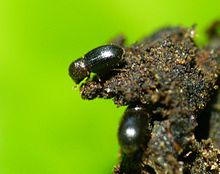pms
nòm ant ël fil


Hypothenemus is a genus of oriental bark beetles in the family Curculionidae. There are more than 200 described species in Hypothenemus. They are common in tropical and subtropical areas worldwide, and found less often in temperate areas of eastern North America and eastern Asia. The small beetles are typically 0.6 mm to 2.2 mm in length, males smaller than females.[1][2]
 Hypothenemus hampei
Hypothenemus hampei Hypothenemus is a genus of oriental bark beetles in the family Curculionidae. There are more than 200 described species in Hypothenemus. They are common in tropical and subtropical areas worldwide, and found less often in temperate areas of eastern North America and eastern Asia. The small beetles are typically 0.6 mm to 2.2 mm in length, males smaller than females.
Hypothenemus est un genre d'insectes de l'ordre des coléoptères appartenant à la famille des Curculionidae.
Ce genre, à répartition pantropicale ou subtropicale, comprend 179 espèces[1].
Plusieurs espèces de ce genre sont des ravageurs des cerises du caféier, notamment Hypothenemus hampei, espèce d'origine africaine qui s'est répandue dans la quasi-totalité de l'aire de culture du caféier, Hypothenemus seriatus (Brésil), Hypothenemus opacus (Brésil), Hypothenemus flavosquanious (Afrique occidentale), Hypothenemus pallidus (Afrique occidentale), Hypothenemus fuscicollis (Brésil), Hypothenemus buscki (Colombie), Hypothenemus plumeriae (Brésil) et Hypothenemus polyphagus (Afrique tropicale)[2].
Selon ITIS (27 oct. 2012)[3] :
Selon NCBI (27 oct. 2012)[4] :
Hypothenemus est un genre d'insectes de l'ordre des coléoptères appartenant à la famille des Curculionidae.
Ce genre, à répartition pantropicale ou subtropicale, comprend 179 espèces.
Plusieurs espèces de ce genre sont des ravageurs des cerises du caféier, notamment Hypothenemus hampei, espèce d'origine africaine qui s'est répandue dans la quasi-totalité de l'aire de culture du caféier, Hypothenemus seriatus (Brésil), Hypothenemus opacus (Brésil), Hypothenemus flavosquanious (Afrique occidentale), Hypothenemus pallidus (Afrique occidentale), Hypothenemus fuscicollis (Brésil), Hypothenemus buscki (Colombie), Hypothenemus plumeriae (Brésil) et Hypothenemus polyphagus (Afrique tropicale).
Hypothenemus is een geslacht uit de familie van de snuitkevers (Curculionidae). De wetenschappelijke naam werd voor het eerst gepubliceerd door John Obadiah Westwood in 1836.[1] Hij beschreef Hypothenemus als een ondergeslacht van Tomicus. Hij beschreef als eerste soort tevens Tomicus (Hypothenemus) eruditus, een kleine kever die de omslag en binding van een boek aantastte en zich voedde met het kartonpapier en de lijm.
Er zijn ongeveer 240 soorten beschreven in dit geslacht.[2] Een aantal daarvan zijn schadelijk, in het bijzonder de koffiebesboorder Hypothenemus hampei (Ferrari, 1867), die gangen boort in koffiebessen om er eitjes in te deponeren; de larven voeden zich met de koffiebes. Oorspronkelijk afkomstig uit Afrika, vormt deze kever inmiddels de grootste bedreiging voor de koffieteelt over de hele wereld. Hoewel cafeïne toxisch is voor insecten, heeft deze soort daar een verdegigingsmechanisme tegen ontwikkeld: micro-organismen in zijn microbioom breken de cafeïne af.[3][4]
Bronnen, noten en/of referentiesHypothenemus is een geslacht uit de familie van de snuitkevers (Curculionidae). De wetenschappelijke naam werd voor het eerst gepubliceerd door John Obadiah Westwood in 1836. Hij beschreef Hypothenemus als een ondergeslacht van Tomicus. Hij beschreef als eerste soort tevens Tomicus (Hypothenemus) eruditus, een kleine kever die de omslag en binding van een boek aantastte en zich voedde met het kartonpapier en de lijm.